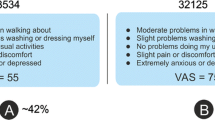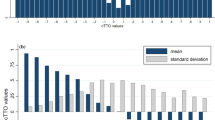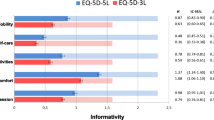Abstract
Objective
This study aimed to test multiplicative modelling with EQ-5D-3L time-trade-off (TTO) and visual analogue scale (VAS) values.
Methods
A multi-stage sampling design was adopted for the study and data collection took place in three phases in 2010, 2011, and 2012 in the Northern region of Malaysia. Face-to-face interviews involved respondents answering both 13 TTO and 15 VAS valuation tasks were carried out. Both additive and multiplicative model specifications were explored using the valuation data. Model performance was evaluated using out-of-sample predictive accuracy by applying the cross-validation technique. The distribution of the model values was also graphically compared on Bland–Altman plots and kernel density distribution curves.
Results
Data from 630 and 611 respondents were included for analyses using TTO and VAS models, respectively. In terms of main-effects specifications, cross-validation results revealed a slight superiority of multiplicative models over its additive counterpart in modelling TTO values. However, both main-effects models had roughly equal predictive accuracy for VAS models. The non-linear multiplicative model with I32 term, MULT7_TTO, performed best for TTO models; while, the linear additive model with N3 term, ADD11_VAS, outperformed the other VAS models. Multiplicative modelling neither altered the dimensional rankings of importance nor did it change the distribution of values of the health states.
Conclusion
Using EQ-5D-3L valuation data, multiplicative modelling was shown to improve out-of-sample predictive accuracy of TTO models but not of VAS models.


Similar content being viewed by others
References
Gudex, C.: The descriptive system of the EuroQol Instrument. In: Kind, P., Brooks, R., Rabin, R. (eds.) EQ-5D concepts and methods: A developmental history, pp. 19–27. Springer, Netherlands (2005)
Herdman, M., Gudex, C., Lloyd, A., Janssen, M., Kind, P., Parkin, D., Bonsel, G., Badia, X.: Development and preliminary testing of the new five-level version of EQ-5D (EQ-5D-5L). Qual. Life Res. 20(10), 1727–1736 (2011). https://doi.org/10.1007/s11136-011-9903-x[doi]
Rencz, F., Gulácsi, L., Drummond, M., Golicki, D., Prevolnik Rupel, V., Simon, J., Stolk, E.A., Brodszky, V., Baji, P., Závada, J., Petrova, G., Rotar, A., Péntek, M.: EQ-5D in Central and Eastern Europe: 2000–2015. Qual. Life Res. 25(11), 2693–2710 (2016). https://doi.org/10.1007/s11136-016-1375-6
Rowen, D., Azzabi Zouraq, I., Chevrou-Severac, H., van Hout, B.: International regulations and recommendations for utility data for health technology assessment. Pharmacoeconomics 35(Suppl 1), 11–19 (2017). https://doi.org/10.1007/s40273-017-0544-y
Kennedy-Martin, M., Slaap, B., Herdman, M., van Reenen, M., Kennedy-Martin, T., Greiner, W., Busschbach, J., Boye, K.S.: Which multi-attribute utility instruments are recommended for use in cost-utility analysis? A review of national health technology assessment (HTA) guidelines. Eur J Health Econom (2020). https://doi.org/10.1007/s10198-020-01195-8
Malaysia, M.o.H.: Pharmacoeconomic guidelines for Malaysia. In. Ministry of Health Malaysia, Selangor, Malaysia, (2019)
Devlin, N.J., Brooks, R.: EQ-5D and the EuroQol Group: past, present and future. Appl. Health. Econom. Health. Policy. 15(2), 127–137 (2017). https://doi.org/10.1007/s40258-017-0310-5
Xie, F., Gaebel, K., Perampaladas, K., Doble, B., Pullenayegum, E.: Comparing EQ-5D valuation studies: a systematic review and methodological reporting checklist. Med. Decis. Making 34(1), 8–20 (2014). https://doi.org/10.1177/0272989x13480852
Oppe, M., Devlin, N.J., van Hout, B., Krabbe, P.F.M., de Charro, F.: A program of methodological research to arrive at the new international EQ-5D-5L valuation protocol. Value Health 17(4), 445–453 (2014)
Oppe, M., Rand-Hendriksen, K., Shah, K., Ramos-Goñi, J.M., Luo, N.: Euroqol protocols for time trade-off valuation of health outcomes. Pharmacoeconomics 34(10), 993–1004 (2016). https://doi.org/10.1007/s40273-016-0404-1
Brazier, J.: Measuring and Valuing Health Benefits for Economic Evaluation. Oxford University Press, New York, United States (2007)
Rand-Hendriksen, K., Ramos-Goñi, J.M., Augestad, L.A., Luo, N.: Less is more: cross-validation testing of simplified nonlinear regression model specifications for EQ-5D-5L health state values. Value Health 20(7), 945–952 (2017). https://doi.org/10.1016/j.jval.2017.03.013
Luo, N., Liu, G., Li, M., Guan, H., Jin, X., Rand-Hendriksen, K.: Estimating an EQ-5D-5L Value Set for China. Value Health 20(4), 662–669 (2017). https://doi.org/10.1016/j.jval.2016.11.016
Shafie, A.A., Vasan Thakumar, A., Lim, C.J., Luo, N., Rand-Hendriksen, K., Md Yusof, F.A.: EQ-5D-5L valuation for the Malaysian population. Pharmacoeconomics 37(5), 715–725 (2019). https://doi.org/10.1007/s40273-018-0758-7
Wang, P., Liu, G.G., Jo, M.W., Purba, F.D., Yang, Z., Gandhi, M., Pattanaphesaj, J., Ahn, J., Wong, E.L.Y., Shafie, A.A., Busschbach, J.J.V., Luo, N.: Valuation of EQ-5D-5L health states: a comparison of seven Asian populations. Expert Rev. Pharmacoecon. Outcomes Res. 19(4), 445–451 (2019). https://doi.org/10.1080/14737167.2019.1557048
Prevolnik Rupel, V., Srakar, A., Rand, K.: Valuation of EQ-5D-3l health states in Slovenia: VAS based and TTO based Value Sets. Zdravstveno Varstvo 59(1), 8–17 (2020). https://doi.org/10.2478/sjph-2020-0002
Patrick, D.L., Starks, H.E., Cain, K.C., Uhlmann, R.F., Pearlman, R.A.: Measuring preferences for health states worse than death. Med. Decis. Making 14(1), 9–18 (1994)
Liu, G.G., Wu, H., Li, M., Gao, C., Luo, N.: Chinese time trade-offvalues for EQ-5D health states. Value Health 17(5), 597–604 (2014). https://doi.org/10.1016/j.jval.2014.05.007
Lee, Y.K., Nam, H.S., Chuang, L.H., Kim, K.Y., Yang, H.K., Kwon, I.S., Kind, P., Kweon, S.S., Kim, Y.T.: South Korean time trade-off values for EQ-5D health states: modeling with observed values for 101 health states. Value Health (2009). https://doi.org/10.1111/j.1524-4733.2009.00579.x
Gudex, C.: Time trade-off user manual: props and self-completion methods. University of York, In. Centre for Health Economics (1994)
Dolan, P.: Modeling valuations for EuroQol health states. Med. Care 35(11), 1095–1108 (1997)
Shaw, J.W., Johnson, J.A., Coons, S.J.: US valuation of the EQ-5D health states: development and testing of the D1 valuation model. Med. Care 43(3), 203–220 (2005). https://doi.org/10.2307/3768219
Rand-Hendriksen, K., Augestad, L.A., Dahl, F.A.: A critical re-evaluation of the regression model specification in the US D1 EQ-5D value function. Population Health Metrics 10 (2012). https://doi.org/10.1186/1478-7954-10-2
R Development Core Team: R: A language and environment for statistical computing. In. R Foundation for Statistical Computing, (2016)
Md Yusof, F.A., Goh, A., Azmi, S.: Estimating an EQ-5D value set for Malaysia using time trade-off and visual analogue scale methods. Value Health 15(1, Supplement), S85-S90 (2012). https://doi.org/10.1016/j.jval.2011.11.024
Brazier, J., Deverill, M., Green, C.: A review of the use of health status measures in economic evaluation. J. Health Serv. Res. Policy 4(3), 174–184 (1999)
Brazier, J., Ratcliffe, J., Salomon, J.A., Tsuchiya, A.: Measuring and valuing health benefits for economic evaluation. Oxford University Press, New York, United States (2007)
Szende, A., Oppe, M., Devlin, N.: EQ-5D value sets: inventory, comparative review and user guide. Springer, (2007)
Augustovski, F.A., Irazola, V.E., Velazquez, A.P., Gibbons, L., Craig, B.M.: Argentine valuation of the EQ-5D health states. Value Health 12(4), 587–596 (2009). https://doi.org/10.1111/j.1524-4733.2008.00468.x
Bonsel, G.J., Oppe, M., Janssen, M.F.: Unexpected large misspecification effects of health profile selection and interaction analysis to obtain a value function from unsaturated valuation datasets, using the standard EuroQol approach. In: Office, E.G.E. (ed.) Stockholm 2014 EuroQol Proceedings 2014
Gandhi, M., Xu, Y., Luo, N., Cheung, Y.B.: Sample size determination for EQ-5D-5L value set studies. Qual. Life Res. (2017). https://doi.org/10.1007/s11136-017-1685-3
Oppe, M., van Hout, B.: The ‘‘power’’ of eliciting EQ-5D-5L values: the experimental design of the EQ-VT. EuroQol working paper series 17003 (2017)
Chan, K.K.W., Pullenayegum, E.M.: The Theoretical Relationship between Sample Size and Expected Predictive Precision for EQ-5D Valuation Studies: A Mathematical Exploration and Simulation Study. Med. Decis. Making 40(3), 339–347 (2020). https://doi.org/10.1177/0272989X20915452
Dolan, P., Roberts, J.: To what extent can we explain time trade-off values from other information about respondents? Soc. Sci. Med. 54(6), 919–929 (2002)
Badia, X., Herdman, M., Roset Dipstat, M., Ohinmaa, A.: Feasibility and validity of the VAS and TTO for eliciting general population values for temporary health states: A comparative study. Health Servic Outcomes Res Methodol 2(1), 51–65 (2001). https://doi.org/10.1023/A:1011480201653
Acknowledgement
The authors would like to express gratitude to Luo Nan for his ideas during the study design stage and also for providing constructive comments during the early stages of the manuscript and Kim Rand-Hendriksen for his generosity in sharing the R codes used during data analysis.
Funding
The fund was granted by Universiti Sains Malaysia with Grant no. 001/PFARMASI/816114.
Author information
Authors and Affiliations
Corresponding author
Additional information
Publisher's Note
Springer Nature remains neutral with regard to jurisdictional claims in published maps and institutional affiliations.
Electronic supplementary material
Below is the link to the electronic supplementary material.
Rights and permissions
About this article
Cite this article
Shafie, A.A., Vasan Thakumar, A. Multiplicative modelling of EQ-5D-3L TTO and VAS values. Eur J Health Econ 21, 1411–1420 (2020). https://doi.org/10.1007/s10198-020-01233-5
Received:
Accepted:
Published:
Issue Date:
DOI: https://doi.org/10.1007/s10198-020-01233-5




